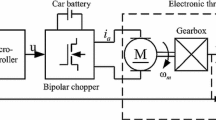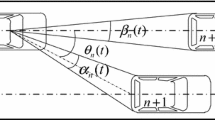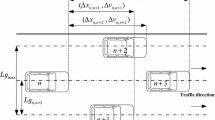Abstract
This study proposes a new car-following model considering the effects of the electronic throttle dynamics to capture the characteristics of connected autonomous vehicular traffic flow without lane discipline. In particular, the proposed model incorporates the effects of both electronic throttle opening angle and lateral gap into the traffic flow model by assuming that the information on electronic throttle dynamics is shared by surrounding vehicles through vehicle-to-vehicle communications. Stability of the proposed model is analyzed using the perturbation method. Numerical experiments analyze three scenarios: start, stop and evolution processes for the scenarios of lane-discipline-based full velocity difference (FVD) model, non-lane-based full velocity difference car-following (NLBCF) model and non-lane-discipline and throttle-based car-following model, respectively. Results from numerical experiments illustrate that the proposed car-following model has a larger stale region compared with the FVD and NLBCF models. In addition, it also demonstrates that the proposed car-following model can better represent the characteristics of connected and autonomous vehicular traffic flow in terms of the responsiveness, smoothness and stability with respect to the position, velocity, acceleration/deceleration and space headway profiles.










Similar content being viewed by others
References
Guler, S.I., Menendez, M., Meier, L.: Using connected vehicle technology to improve the efficiency of intersections. Transp. Res. C Emerg. Technol. 46, 121–131 (2014)
Ge, J., Orosz, G.: Dynamics of connected vehicle systems with delayed acceleration feedback. Transp. Res. C Emerg. Technol. 46, 46–64 (2014)
Li, Y., Zhang, L., Peeta, S., He, X., Zheng, T., Li, Y.: A car-following model considering the effect of electronic throttle opening angle under connected environment. Nonlinear Dyn. 85(4), 2115–2125 (2016)
Ioannou, P., Xu, Z.: Throttle and brake control system for automatic vehicle following. Intell. Veh. Highw. Syst. J. 1, 345–377 (1994)
Li, Y., Yang, B., Zheng, T., Li, Y., Cui, M., Peeta, S.: Extended-state-observer-based double loop integral sliding mode control of electronic throttle valve. IEEE Trans. Intell. Transp. Syst. 16, 2501–2510 (2015)
Chandra, S., Kumar, U.: Effect of lane width on capacity under mixed traffic conditions in India. J. Transp. Eng. 129(2), 155–160 (2003)
Gunay, B.: Car following theory with lateral discomfort. Transp. Res. B Methodol. 41(7), 722–735 (2007)
Yu, S., Shi, Z.: The effects of vehicular gap changes with memory on traffic flow in cooperative adaptive cruise control strategy. Physica A 428, 206–223 (2015)
Li, Y., Zhang, L., Zhang, B., Zheng, T., Feng, H., Li, Y.: Non-lane-discipline-based car-following model considering the effect of visual angle. Nonlinear Dyn. 85(3), 1901–1912 (2016)
Wilson, R., Ward, J.: Car-following models: fifty years of linear stability analysis—a mathematical perspective. Transp. Plan. Technol. 34(1), 3–18 (2011)
Li, Y., Sun, D.: Microscopic car-following model for the traffic flow: the state of the art. J. Control Theory Appl. 10(2), 133–143 (2012)
Saifuzzaman, M., Zheng, Z.: Incorporating human-factors in car-following models: a review of recent developments and research needs. Transp. Res. C 48, 379–403 (2014)
Gipps, P.: A behavioral car-following model for computer simulation. Transp. Res. B Methodol. 15(2), 105–111 (1981)
Bando, M., Hasebe, K., Nakayama, A., Shibata, A., Sugiyama, Y.: Dynamics model of traffic congestion and numerical simulation. Phys. Rev. E 51(2), 1035–1042 (1995)
Helbing, D., Tilch, B.: Generalized force model of traffic dynamics. Phys. Rev. E 58, 133–138 (1998)
Jiang, R., Wu, Q., Zhu, Z.: Full velocity difference model for a car-following theory. Phys. Rev. E 64, 017101–017105 (2001)
Zhao, X., Gao, Z.: A new car-following model: full velocity and acceleration difference model. Eur. Phys. J. B 47(1), 145–150 (2005)
Wang, T., Gao, Z., Zhao, X.: Multiple velocity difference model and its stability analysis. Acta Phys. Sin. 55, 634–640 (2006)
Sun, D., Li, Y., Tian, C.: Car-following model based on the information of multiple ahead & velocity difference. Syst. Eng. Theory Pract. 30(7), 1326–1332 (2010)
Li, Y., Sun, D., Liu, W., Zhang, M., Zhao, M., Liao, X., Tang, L.: Modeling and simulation for microscopic traffic flow based on multiple headway, velocity and acceleration difference. Nonlinear Dyn. 66(1), 15–28 (2011)
Tang, T., Wang, Y., Yang, X., Wu, Y.: A new car-following model accounting for varying road condition. Nonlinear Dyn. 70(2), 1397–1405 (2012)
Tang, T., Shi, W., Shang, H., Wang, Y.: A new car-following model with consideration of inter-vehicle communication. Nonlinear Dyn. 76, 2017–2023 (2014)
Tang, T., Shi, W., Shang, H., Wang, Y.: An extended car-following model with consideration of the reliability of inter-vehicle communication. Measurement 58, 286–293 (2014)
Li, Y., Zhang, L., Zheng, H., He, X., Peeta, S., Zheng, T., Li, Y.: Non-lane-discipline-based car-following model for electric vehicles in transportation-cyber-physical-systems. IEEE Trans. Intell. Transp. Syst. (2017). doi:10.1109/TITS.2017.2691472
Jin, S., Wang, D., Tao, P., Li, P.: Non-lane-based full velocity difference car following model. Physica A 389(21), 4654–4662 (2010)
Li, Y., Zhang, L., Peeta, S., Pan, H., Zheng, T., Li, Y., He, X.: Non-lane-discipline-based car-following model considering the effects of two-sided lateral gaps. Nonlinear Dyn. 80(1–2), 227–238 (2015)
Li, Y., Zhang, L., Zheng, H., He, X., Peeta, S., Zheng, T., Li, Y.: Evaluating the energy consumption of electric vehicles based on car-following model under non-lane discipline. Nonlinear Dyn. 82(1), 1–13 (2015)
Acknowledgements
This work is jointly supported by the National Natural Science Foundation of China under Grant 61773082,61304197 and 61503053, by the Key Project of Basic Science and Emerging Technology of Chongqing under Grant cstc2017jcyjBX0018, by the National Key Research and Development Program under Grant 2016YFB0100906 and the Doctoral Start-up Funds of CQUPT under Grant no. A2012-26.
Open Access
This article is distributed under the terms of the Creative Commons Attribution 4.0 International License (http://creativecommons.org/licenses/by/4.0/), which permits unrestricted use, distribution, and reproduction in any medium, provided you give appropriate credit to the original author(s) and the source, provide a link to the Creative Commons license, and indicate if changes were made.
Author information
Authors and Affiliations
Corresponding author
Rights and permissions
About this article
Cite this article
Li, Y., Zhao, H., Zheng, T. et al. Non-lane-discipline-based car-following model incorporating the electronic throttle dynamics under connected environment. Nonlinear Dyn 90, 2345–2358 (2017). https://doi.org/10.1007/s11071-017-3807-4
Received:
Accepted:
Published:
Issue Date:
DOI: https://doi.org/10.1007/s11071-017-3807-4




